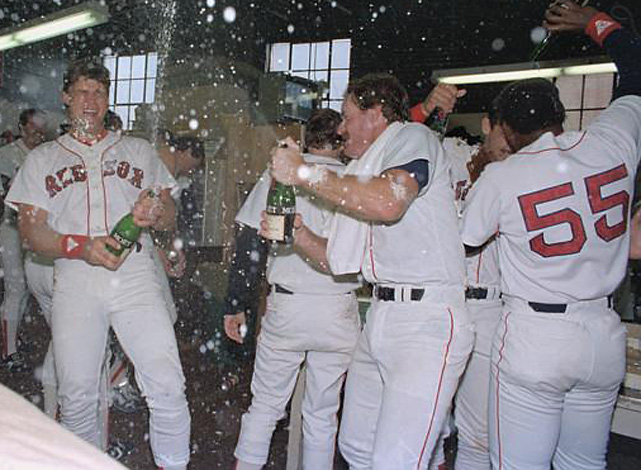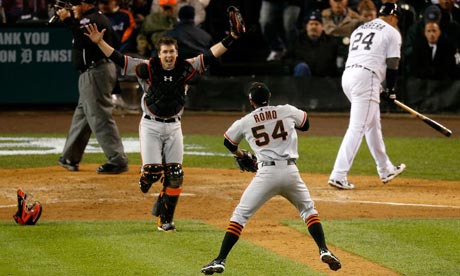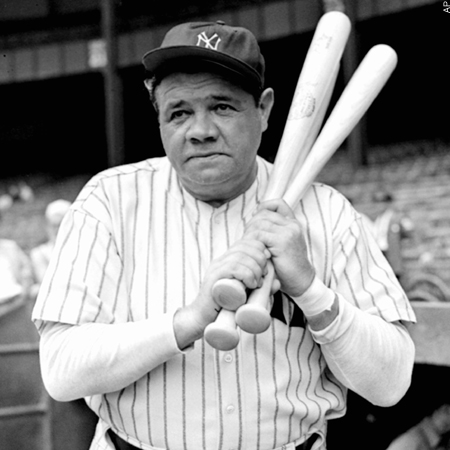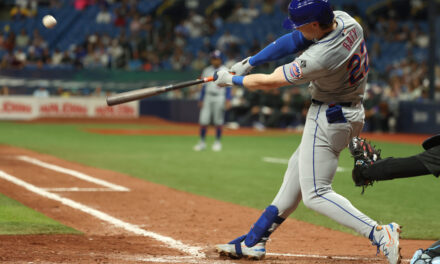October 25, 1986: Boston:
It took 68 years for the Red Sox to end the ‘Curse of the Bambino’ and they did it in historic fashion in front of a sold-out Fenway Park.
The heavily favored Mets, winners of 108 regular season games, turned to Bob Ojeda in hopes of forcing a game 7. Trailing by a run heading to the home half of the eighth, Boston tied the game at 3. The Mets seemed destined to win when they scored two in the top of the tenth for a commanding 5-3 lead.
However, the bullpen could not close it out. After Jesse Orosco retired the first two batters, Boston rallied for an unprecedented three runs in the bottom of the 10th. Several times Boston was down to their last strike but the Sox were amazin. Roger McDowell allowed the tying run to score on a pitch in the dirt that Gary Carter couldn’t handle.
Tied 5-5 and with the winning run on second base, centerfielder Dave Henderson hit a slow roller along the first base line. Somehow, the ball skipped below the glove of Keith Hernandez, and Red Sox third baseman Wade Boggs raced home, hands atop his helmet in disbelief, and into the arms of his teammates.
In other Baseball news, Pirates young slugger Barry Bonds appears to be getting bigger…
Okay, okay, you’re all wondering what I’m smoking and where you can get some. I admit to taking some literary license and rewriting history. Or am I? Game 6 did not end this way. But it definitely could have had Bud Selig been commissioner back then.
Beginning in 2003, Commissioner Selig, along with approval from the Player’s Union, decided that the winner of the All-Star Game would have home field advantage in the World Series. And just like that the National Pastime’s two greatest institutions, the All-Star Game and the World Series, would be forever altered. Both had remained relatively untouched since their inceptions in 1933 and 1903 respectively. And then along came Bud.
The reason was simple. Viewership for the Midsummer Classic was down. Interest was waning. The powers-that-be believed the game should now carry significance. For seventy years the All-Star Game was by and large an exhibition put on for the fans. It gave us a chance to see the best and brightest from each league. Now that’s changed. And not for the better.
Since 2003, the league that won the All-Star Game has gone on to win the World Series 8 out of 12 times. In other words, an ‘exhibition game’ in July has direct influence over the Fall Classic in October. It also can–and has–changed the history of the game.
In 1986, the Mets returned to Shea where they rallied to win games 6 and 7. However, had Selig’s rule been in place then, it’s likely 1969 would be the Mets only championship season. The AL won the 1986 All-Star Game. Boston would have had home field advantage, not us.
In 2005, the White Sox won the Series in 5 games. It was their first championship since 1917 when they were led by guys named Joe Jackson, Eddie Cicotte and Buck Weaver. The victory, however, was bittersweet for Chicagoans. Had the home field advantage rule not been in place, the Sox would have been home for games 3, 4 and 5, not on the road. Their first championship would have—and should have—been in Chicago, not Houston.
Game 6 of the 2011 World Series was arguably the greatest post-season game ever played. Facing elimination, the Cardinals returned to STL needing 2 wins. They went to the HOME half of the 8th inning of game 6 trailing 7-4. They scored 1 in the bottom of the frame, two more in the HOME half of the ninth, twice more in the HOME half of the 10th and finally won it in the HOME half of the 11th. The following day they won Game 7. Had the old format been retained and home field alternated year-to-year, Texas would have hosted games 6 and 7 and most likely would have won their first Championship in team history.
San Francisco fans waited more than half a century to see their Giants win it all. Yet, despite the fact their club has won 3 titles in the last 5 years, all series clinchers have come on the road. Once again, had the original alternating format been in place, the NL club was scheduled to host 4 of the 7 games in even years. The Giants would’ve won 2010 and 2012 at AT&T Park, not in Texas and Detroit.
The All-Star Game now carries major importance. Yet, it still maintains that Exhibition Game feel. If the point is to win—and it clearly is—why does every team need to be represented? Why does the manager need to stress about making sure every guy gets in as much as he stresses about winning? We are NL fans. We want the NL to win. Therefore, I want the best guys out there for 9 innings. I want to see Max Scherzer pitching to Buster Posey for all 27 outs. I want Paul Goldschmidt to have at least 4 AB’s.
Why should ONE game have such a huge bearing on the Fall Classic? Since there’s interleague games daily, why not just look at the best head-to head records throughout the season? Whichever league wins more over the course of 6 months, not one night, gets home field advantage. After all, as it stands now, how many of us really care when the AL Mariners play the NL Rockies?
As a kid growing up in the 70’s, watching the All-Star Game was one of my favorite times of the year. Being a NL fan, the biggest stars in the AL were just names in a box score. The Mid-Summer Classic gave me a chance to see my Baseball cards come to life. I could actually see a Nolan Ryan fastball rather than hearing about it. I could witness Harmon Killebrew uncoil from his crouch. I could watch Rod Carew change his stance on each pitch depending on the count. It was a wonderful thing.
Even before these recent changes, the luster of the ASG has diminished. MLB Network, ESPN, YouTube, etc…obviously weren’t around back then. Seeing Mike Trout every night on the highlight reel is nothing special. Seeing Al Kaline Saturday afternoon during an episode of “This Week in Baseball” was.
No shock here but the first player to ever go deep in an All-Star Game was Babe Ruth. When returning to the dugout, The Bambino said, “Let’s show these NL bums how we play.” From 1933 through the early 90’s, there was indeed a rivalry between the leagues. That, too, is now gone. Players have no qualms about switching teams, much less switching leagues. The biggest free agents last winter—Max Scherzer, Pablo Sandoval and James Shields—all changed leagues. And hey, if entire franchises can switch (Houston to the AL, Milwaukee to the NL), why shouldn’t players?
Ironically, despite the Commish’s best efforts to increase interest, it’s failed. The 2002 ASG, the final one without ‘meaning,’ was watched in 10 million homes. In 2013, just 7.5 million tuned in, a drop of 25%.
Keeping in mind I am a traditionalist, I feel it’s imperative that this ‘experiment’ be put to rest. Let’s have the All-Star Game mean exactly what it was designed for: a chance to take a breather for a few days, sit back and watch the best players in the game display their talent.

















